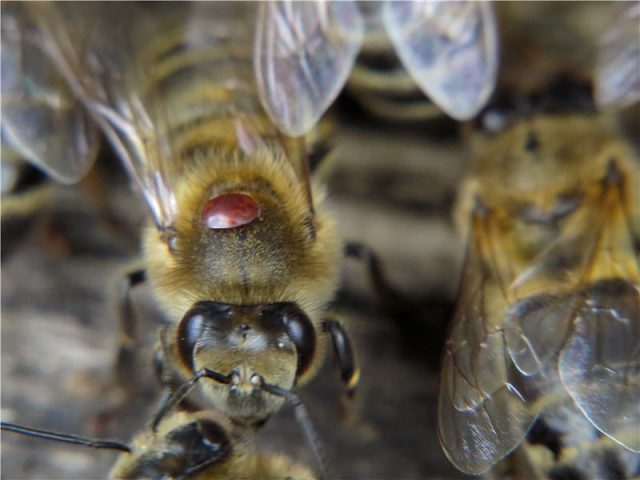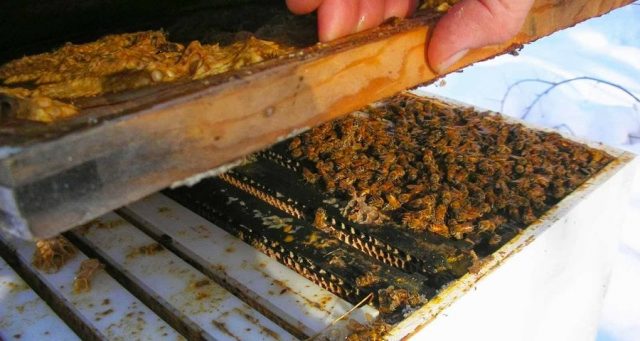Content
- 1 What diseases in bees is the drug Polisan used for?
- 2 Composition, release form
- 3 Pharmacological properties
- 4 Polisan for bees: instructions for use
- 5 Dosage, rules for using the drug for bees Polisan
- 6 Side effects, contraindications, restrictions on use
- 7 Shelf life and storage conditions
- 8 Conclusion
- 9 Testimonials
Beekeepers often face various diseases in bees. In this case, it is necessary to use only proven and effective drugs. Polisan is a veterinary remedy that has been used for several years to treat a bee colony from ticks.
What diseases in bees is the drug Polisan used for?
Bees are susceptible to mite infestations. Such diseases are called acarapidosis and varroatosis. Ticks reproduce and breed in winter, when the bee colony is in an enclosed space. The parasites infect the respiratory tract of the bees, and they die.
The first signs of the disease are difficult to notice. It can be asymptomatic for a long time. Later, beekeepers observe the birth of bee offspring with a small body weight. Such individuals do not live long. In summer, insects cease to perform their functions and fly out of the hive.
In this case, already at the end of summer, after pumping out the honey, the treatment of the hive with the preparation "Polisan" is started. This is done during a period when the air temperature has not dropped below + 10 Cᵒ. In the evening, as soon as the bees fly into the hive, processing begins. The drug is opened immediately before the procedure. The drug will need 1 strip for 10 hives.
Tick-infested families are treated twice. The interval between fumigations is 1 week. For preventive purposes, young bee colonies are fumigated in spring and late autumn 1 time. After this procedure, honey can be eaten.
Composition, release form
"Polisan" is a solution of bromopropylate applied to thermal strips 10 cm long and 2 cm wide. One package contains 10 thermal strips, hermetically sealed in foil. In the form of tablets, aerosols or powder, which contains bromopropylate, "Polisan" is not produced. The agent is used to fumigate bees affected by acarapidosis and varroatosis.
Pharmacological properties
The drug has acaricidal (anti-mite) action. The smoke, which contains bromopropylate, is emitted during the combustion of smoke strips. It destroys pests in the hive and on the body of the bee.
Polisan for bees: instructions for use
The drug is used in the spring after the first flight of bees. In autumn - after honey pumping. Processing is carried out early in the morning or late in the evening, during a period of complete calm of insects.
Before starting processing, stretchers are mounted in the hives in the form of a grid. The strips of "Polisan" are set on fire, they wait until they start smoldering well, and then they are extinguished. At this time, smoke will start to stand out. The strip is placed on the bottom of the mesh stretcher and allowed to burn out. After the bottom and side entrance, it is necessary to close tightly.
In accordance with the instructions for "Polisan", the treatment is continued for an hour. After this time, the hive is opened and the stretcher is removed. If the strip is not completely decayed, the treatment should be repeated using half of a new Polisan thermal strip.
Dosage, rules for using the drug for bees Polisan
For a one-time treatment of one hive, you need to take 1 strip of the drug. Fumigation is carried out one month before the start of honey collection or immediately after it. The smoke aerosol is opened immediately before processing.
Side effects, contraindications, restrictions on use
There are no side effects from the use of this drug. It is not recommended to use more than 1 Polisan thermal strips per hive. The drug is not used in the winter during the hibernation of bees and in the summer during the honey plant.
Shelf life and storage conditions
Thermal strips "Polisan" retain their properties for 2 years from the date of issue. The drug is stored sealed in a cool dark place. Storage air temperature 0-25 Cᵒ.
Conclusion
Polisan is an effective modern remedy with acaricidal effect. It is widely used in veterinary medicine to combat ticks in bees. It has been proven to be effective and harmless to the bee colony.
Testimonials
Reviews of beekeepers about Polisan are the most positive. The drug is popular with consumers for its ease of use and lack of side effects.











